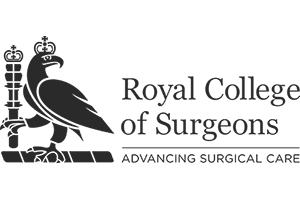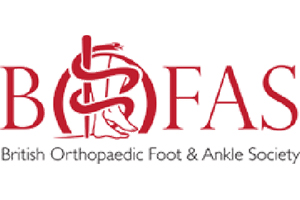A metatarsal osteotomy is an operation for bunions (hallux valgus).
Why would it be done?
Surgery for a bunion may be advised if simple measures, such as well-fitting shoes, simple painkillers and padding do not relieve the discomfort of the bunion. It is only appropriate if you are willing to be realistic about footwear after surgery, and understand and accept the potential problems of the procedure.
What does the operation involve?
A cut is made on the side of the bunion. The big toe joint is opened and the bony lump is removed. The first metatarsal is cut through, re-positioned and fixed with one or two screws. Sometimes a second cut is made between the first and second toes to free up the tight tissues on this side of the toe. The soft tissues on the other side of the joint are tightened to correct the deformity and the wound stitched up. The foot is dressed in soft bandages.
Can it be done as a day case operation?
If you are medically fit, have someone who can collect you and look after you after the operation, and you are comfortable afterwards, the operation can be done on a day case basis. However, if you have other medical problems such as diabetes, asthma or high blood pressure, you may have to be admitted the day before for tests and stay overnight after surgery. If you cannot be collected and looked after you must stay overnight to avoid complications. The commonest reason for having to stay overnight after bunion surgery is for pain control, as many of these operations involve breaking and re-positioning a bone. They may therefore be quite painful immediately afterward. Local anaesthetic injections can help with this, but not everyone is comfortable to go home.
Will I have to go to sleep (general anaesthetic)?
The operation can be done under general anaesthetic (asleep). Alternatively, an injection in the back, leg or around the ankle can be done to make the foot numb while the patient remains awake. Local anaesthetic injections do not always work and in that case you may have to go to sleep if the operation is to be done. Your anaesthetist will advise you about the best choice of anaesthetic for you.
In addition, local anaesthetic may be injected into your leg or foot while you are asleep to reduce the pain after the operation even if you go to sleep for the surgery. You will also be given pain-killing tablets as required.
Will I have a plaster on afterwards?
You don’t usually need a plaster after a metatarsal osteotomy. We will put dressings and a bandage on your foot and you can walk on the heel in a protective sandal with a stiff sole. After 2 weeks, the stitches are removed and a splint is used to hold the great toe in the corrected position for a further 4 weeks. However, if your bone is particularly soft or the soft tissue repair of the joint needs extra protection, a plaster shoe will be put on which you would usually wear for four weeks.
What will happen afterwards?
You can go home when comfortable and safe. An X-ray may be taken before you go home. For the first 2 weeks, you should avoid walking if possible and only put your weight through the heel. When not walking, rest with your foot elevated to reduce swelling.
You will be seen in the clinic 2 weeks after your operation. The dressings will be removed, the wound examined, the stitches removed if necessary, and an X-ray taken if it was not done in hospital. You will then have a splint put on your toe to hold it in position. You will then be more mobile and able to walk on your heel using crutches to support you. You will be able to remove the splint for bathing and showering.
Another clinic appointment will be made for 4 weeks later. At this time the splint will be removed, the toe examined and another X-ray taken. If this shows the osteotomy has fused, you can leave the splint off. If the osteotomy is not yet solid, you may need to continue using the splint for another 3-4 weeks. The process will then be repeated.
How soon can I….
Walk on the foot?
You can do so immediately, but for the first 14 days you should avoid walking if possible and put all of your weight on the heel. When not walking you must rest with you foot elevated as much as possible to reduce swelling. After this you can be more mobile but you must still walk on your heel.
Go back to work?
This depends on what you do and how you get to work. If you have a sitting-down job that you could do with your foot in bandages or plaster, and you can get to work, you could probably go back to work 2-3 weeks after surgery. On the other hand, if you have a heavy manual job you may be off for up to 3 months. If you need to drive to work, this will affect when you can go back. Your surgeon will advise you about going back to work.
Drive?
Once your splint has been removed you may be able to start driving again. You must be comfortable and not too stiff before trying to drive. Start by sitting in the car and trying the pedals then drive round the block. Drive short distances before long ones. Remember, if you cannot safely make an emergency stop your insurance will not cover you in the event of an accident. Ask your surgeon when it is safe for you to drive again.
Play sport?
After your splint has been removed, you can start gently exercising your foot and walking further each day. When you are comfortable doing this you can start gentle running and stretching. Contact, twisting and impact sports can follow as comfort dictates. Everyone is different in how quickly they can take up exercise again: be guided by your own body’s reactions and the advice of your surgeon. Most people can get back to most of their previous activities within 6 months of bunion surgery.
What can go wrong?
Research shows that 85% of people who have bunion corrections are satisfied with the results. However, a number of problems can arise.
The big toe is usually stiffer than before. For most people this does not matter, but for athletes or dancers it is very important.
The big toe is slightly weaker with a bunion, and this transfers weight onto the ball of the foot. After bunion surgery, this transfer of weight can increase. Therefore, if you have pain under the ball of the foot (“metatarsalgia”) it may be worse after bunion surgery, and it may also develop for the first time. Careful surgical technique can reduce this risk, but it cannot avoid it completely. Most people who develop metatarsalgia are comfortable with a simple insole in the shoe but occasionally surgery is required.
In some people the big toe slowly tilts back toward the original position and occasionally this is bad enough to need to have the operation redone. On the other hand, the toe can tilt the other way, though much more rarely. Again, occasionally this is bad enough to need to have the operation redone.
Infections in the wound, plaster problems and minor damage to the nerves of the toe can occur in any foot surgery. Usually these are minor problems that get better quickly.
The foot tends to swell up quite a lot after surgery. Swelling is part of your body’s natural response to any injury and surgery is no exception. In addition, your foot is at the bottom of your body so fluid tends to collect in its tissues (“at the bottom of the slope”) and cause swelling. People vary in how quickly this swelling disappears after an operation and 6 months is not all that unusual. Provided you are not having undue pain or inflammation there is probably nothing to worry about and you can afford to give it time.
This looks like a lot of possible problems, but in fact most people do not get them and are satisfied with their bunion surgery.





